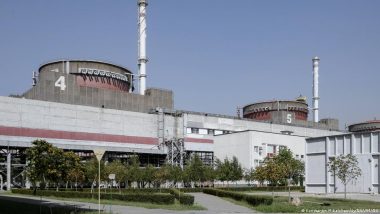Ukraine's Zaporizhzhia power plant is Europe’s largest nuclear facility. It’s also central to Russia’s war. Experts say a meltdown would spell disaster.The International Atomic Energy Agency has repeatedly raised concerns about the war in Ukraine and the threats it poses to the Zaporizhzhia nuclear power plant (ZNPP), and the risks it sees for the people who live in the area.
Russia has controlled the ZNPP since March 2022, just weeks after the war started. The ZNPP is located in the southeast of the country on the banks of the Dnipro river.
In May, IAEA Director General Rafael Grossi said that the general situation in the area near the ZNPP was becoming “increasingly unpredictable and potentially dangerous."
A month later in June, when the Kakhovka dam was blown up, the IAEA said the severe damage had lead to “a significant reduction in the level of the reservoir used to supply cooling water to the ZNPP.”
The water is essential for cooling residual heat from the ZNPP reactors and its spent fuel ponds, and for cooling of emergency diesel power generators at the site.
The explosion at the Kakhovka dam came after missile strikes in March 2023 had caused outages and left the plant running on those emergency diesel generators.
That backup power supply is itself vital for cooling reactor fuel at the plant and preventing a nuclear meltdown, which would release dangerous thermal energy and radiation into the atmosphere.
Grossi said June 6 that there was “no immediate risk to the safety of the plant” and that there were “a number of alternative sources of water.”
In May 2023, more than 1,500 people were reported to have been forcibly evacuated by Russian forces in the area in May.
Nuclear poses two threats in the Russia-Ukraine war
When people think about nuclear threats and the war in Ukraine, most consider two possibilities: What would happen if an accident occurred at a Ukrainian nuclear plant? And what would happen if a nuclear weapon were deployed?
For this article, we talked to experts about the health impact the Fukushima and Chernobyl disasters had on surrounding populations, and asked them to explain the degree to which those disasters might provide a framework for our current understanding of risk at Zaporizhzhia.
In the next article in this series, we explain the health effects linked to the detonation of nuclear weapons at Hiroshima and Nagasaki, and also look at what could happen if nuclear weapons were detonated in today's world.
Zaporizhzhia under occupation
Ukraine's Zaporizhzhia power plant is located close to the country's southern border. With six reactors on site, Zaporizhzhia is Europe's largest nuclear power plant. In 2022, it became the first active nuclear plant in history to continue operations in the midst of a war.
When occupying forces seized the plant in March 2022, experts tried to weigh up how a potential accident there would compare with the 1986 Chernobyl disaster — an event that for decades marked the worst nuclear power accident in history. The Chernobyl meltdown released radiation across Europe, affecting the lives of humans, plants and animals throughout the region.
Over 30 plant workers died in the three months following the disaster at the Soviet power station, Chernobyl, as a direct result of the meltdown.
A report published by the Chernobyl Forum, a group of UN agencies formed in 2003 to assess the health and environmental consequences of the accident, suggested in 2006 that it will cause at least 4,000 cancer deaths in the long term, although that estimate is contested.
Did Soviet officials try to downplay the aftermath of Chernobyl?
Some experts say the impact of the disaster was concealed by Soviet officials in an attempt to downplay its severity. One of them is Massachusetts Institute of Technology (MIT) professor Kate Brown.
Brown has conducted extensive research on the impact radiation has had on people's health in Ukraine and surrounding countries since the 1986 accident.
In a Greenpeace report published in 2006, researchers estimated the predicted death toll at around 90,000 — nearly 23 times the number suggested by the Chernobyl Forum report.
Edwin Lyman, a physicist and director of Nuclear Power Safety with the US-based Union of Concerned Scientists, said he, "doesn't consider the Chernobyl Forum report to be authoritative."
Lyman said the Forum's report based its cancer death predictions only on cases within the former Soviet Union, ignoring exposure to populations in other parts of Europe and the northern hemisphere. The original Chernobyl health impact report conducted by UN agencies and published in 1988, did address the global exposure to radiation in response to the accident, and estimated it would ultimately correspond to 30,000 or more cancer deaths, Lyman said.
"The fundamental issue is whether one believes that low-level exposures will cause cancer or not — and the worldwide expert consensus is that they do. The Chernobyl Forum essentially assumed otherwise," he said, calling the study a "highly political document with conclusions that were carefully massaged to minimize the impacts of the accident."
Studies following the survivors of the Chernobyl disaster have shown an increase in cases of thyroid cancer. In the decades following the accident, researchers detected rates of that particular condition in young people in the former Soviet Union that were around three times higher than expected. This increase is partly attributed to the consumption of tainted milk, studies reported.
However, according to Lyman, the large studies outlining overall cancer risk were published in the early 2000s, at a time when many cancers that could have been triggered by the Chernobyl disaster may not yet have started showing up. And nearly 20 years later, there hasn't been any comprehensive follow-up to these reports.
Reports on the disaster's health impact also note high rates of depression and anxiety in the surrounding population.
Fukushima — a better comparison
Lyman said any fallout from an accident at the Zaporizhzhia power plant would have more in common with the fallout from the 2011 Fukushima nuclear disaster in Japan.
"The consequences that led to such a large and wide dispersal of radioactive activity [at Chernobyl] are probably less likely to occur at the reactors at Zaporizhzhia, which are light water reactors more similar to the reactors in Germany or elsewhere in the West," he said.
The nuclear accident in Fukushima marks the only other disaster at a plant that has been rated a 'seven' on the IAEA's International Nuclear Event Scale.
It was generated by a powerful tsunami and earthquake that caused the plant to lose power, prompting three nuclear meltdowns, hydrogen explosions and extensive releases of radiation from the facility.
Official reports have concluded that although many people died in the tsunami and earthquake, none died in direct response to the nuclear incident. Aside from radiation sickness experienced by people in the direct vicinity, they say, the biggest health impact has been the psychological stress people nearby experienced when they were evacuated.
Today, researchers say the Fukushima incident has left only a negligible mark on the surrounding environment, because much of the radiation was released into the nearby sea.
"Zaporizhzhia is landlocked, so that wouldn't be the case. But still, you would expect probably less radioactive material released and dispersed less widely," Lyman said.
Lyman added that the level of radiation a potential accident at Zaporizhzhia could release would depend on whether the accident was technical, such as a response to the facility losing power for multiple days, or otherwise related to combat, in which case the radiation would be released more quickly. In a situation like that, the severity of any consequences would probably fall somewhere in between that of what happened at Chernobyl and what happened at Fukushima, he said.
"I think the likelihood of another Chernobyl-like event affecting Germany is lower," he said. "There would probably be measurable impacts, but not as great as what was experienced in 1986."
Ukraine's other reactors also present a risk
Zaporizhzhia drew a lot of attention when it came under direct Russian control.
But Lyman said he was also concerned about the other plants in Ukraine, including the inactive one at Chernobyl and three other active sites, which are older than Zaporizhzhia. That makes them even more susceptible to catastrophic failure in the event of an accident.
"There are three other nuclear plants in Ukraine that are closer to the western border. So, they're away from the front, but they're still within range of Russian rocket fire or drones," said Lyman.
He said that although none of those reactors were the same model as those at Chernobyl, some are older Soviet light-water reactors that wouldn't be as resistant to an attack as the plant at Zaporizhzhia.
"If things unravel, and they become more affordable to attack, that could be a greater concern to Western Europe," he said.
Edited by: Derrick Williams and Carla Bleiker
This article was originally published on November 8, 2022. It was last updated on June 6, 2023, to reflect developments in the Russia-Ukraine war and renewed concern over the stability of the Zaporizhzhia nuclear power plant. It is the first of two articles on the threats posed by nuclear technology and weapons in the war.
(The above story first appeared on LatestLY on Jun 06, 2023 06:00 PM IST. For more news and updates on politics, world, sports, entertainment and lifestyle, log on to our website latestly.com).













 Quickly
Quickly











